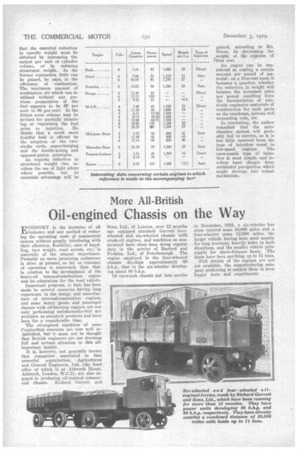More All-British
Page 56

If you've noticed an error in this article please click here to report it so we can fix it.
Oil-engined Chassis on the Way
MI CONOMY is the keystone of all
A r industry and any method of reduc, lug the operating costs of commercial motors without greatly interfering with their efficiency, flexibility, ease of handling, tare weight, road speeds, etc.;'is naturally of the utmost importance. Probably no more promising endeavour is afoot at present, so far as economy of operation is concerned, than that in relation to the development of the heavy-oil internal-combustion engine and its adaptation for the road vehicle.
Important progress, in fact, has been made by several Concerns having long experience in the design and manufacture .of internal-combustion engines, and some heavy goods and passenger chassis with oil-burning engines are not only performing satisfactorily shut are available as standard products and have been for a considerable time.
The oil-engined machines of some Continefital concerns are now well established, but it must not be thought that British engineers are not devoting full and serious attention to this all important matter. .
It is, however, not generally known that companies associated in that isowerful organization, Agricultural and General Engineers, Ltd. (the head office of which is at Aldwych House, ..klilwycb, Loudon. W.C.2), are also engaged in producing oil-engined commercial chassis. Diehard -Garrett and Sons, Ltd., of Leiston, over 12 months ago equipped standard Garrett fourwheeled and six-wheeled chassis with crude-oil engines, and maclaines so constructed have since been doing regular duty in the service of Barford and Perkins, Ltd., of Peterborough. The engine employed in the four-wheeled chassis de elope approximately 60 b.h.p., that in the six-wheeler developing about 80 b.h.p.
Of twosuch chassis put into service
in November, 1928, a six-wheeler has since covered some 16,000 miles and a four-wheeler some 12,000 miles, the larger vehicle having been used matnly for long journeys, heavily laden in both directions, and the smaller vehicle principally for short-distance hauls. The loads have been anything up to 11 tons.
Full details of the engines are not yet available, the manufacturing company preferring to subject them to even longer tests and experiments




















































































































